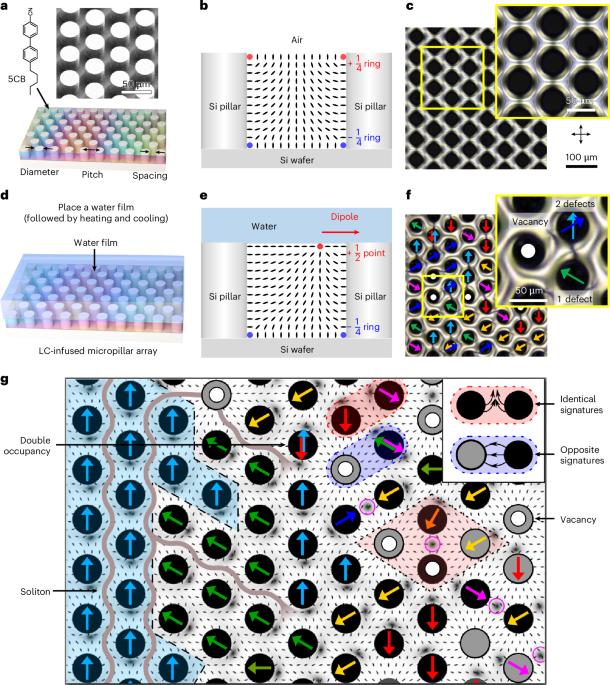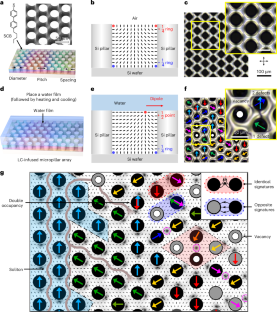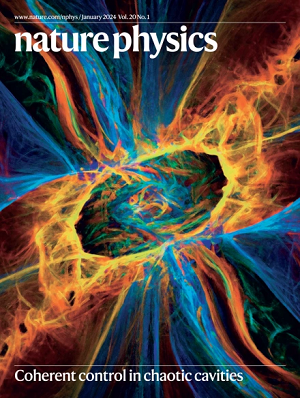几何挫折向列液晶中的多稳定极性织构
IF 18.4
1区 物理与天体物理
Q1 PHYSICS, MULTIDISCIPLINARY
引用次数: 0
摘要
利用多个外场操纵极性实体的能力可以在自旋系统、光子学、超材料和软物质中实现功能和应用。既具有晶体结构又具有液体流动性的液晶,是一种很有前途的操纵极性分子有序相的平台,特别是铁电相。然而,棒状液晶分子主要形成极性向列相,实现极性对称是具有挑战性的。本文报道了一种利用向列液晶的几何晶格约束在介观超材料尺度上诱导平面极性有序的方法。我们将向列液晶限制在微柱阵列中,形成弹性偶极子的拓扑缺陷-柱对,其顶部界面与非混相流体接触。由此产生的偶极晶格构型可以通过流动顶部流体进行流变编程,即使在流动停止后也能保持,这一现象归因于偶极子的取向多稳定性。这种多存储器效应使方向信息的编码和重新配置成为可能。总的来说,这些结果促进了我们对约束和剪切流动下拓扑偶极子的理解,使流动剖面的检测、跟踪和记录成为可能,并有助于刺激响应材料的开发。本文章由计算机程序翻译,如有差异,请以英文原文为准。


Multistable polar textures in geometrically frustrated nematic liquid crystals
The ability to manipulate polar entities with multiple external fields could enable functionalities and applications in spin systems, photonics, metamaterials and soft matter. Liquid crystals that exhibit both a crystalline structure and liquid fluidity represent a promising platform for manipulating phases with polar molecular order, notably ferroelectric ones. However, achieving a polar symmetry is challenging with rod-shaped liquid crystal molecules, which form predominantly apolar nematic phases. Here we report an approach in which a geometric lattice confinement of nematic liquid crystals is used to induce planar polar order on the scale of a mesoscopic metamaterial. We confine the nematic liquid crystal in a micropillar array, forming topological defect–pillar pairs of elastic dipoles with a free top interface in contact with an immiscible fluid. The resulting dipole lattice configurations can be programmed rheologically by flowing the top fluid and maintained even after flow cessation, a phenomenon attributed to orientational multistability of the dipoles. This multimemory effect enables the encoding and reconfiguration of directional information. Overall, these results advance our understanding of topological dipoles under confinement and shear flow, enabling the detection, tracking and recording of flow profiles and could facilitate the development of stimuli-responsive materials. Programmable topological dipoles could be used in stimuli-responsive materials. Now it is shown that confinement of an apolar liquid crystal results in controllable polar arrangements of elastic dipoles.
求助全文
通过发布文献求助,成功后即可免费获取论文全文。
去求助
来源期刊

Nature Physics
物理-物理:综合
CiteScore
30.40
自引率
2.00%
发文量
349
审稿时长
4-8 weeks
期刊介绍:
Nature Physics is dedicated to publishing top-tier original research in physics with a fair and rigorous review process. It provides high visibility and access to a broad readership, maintaining high standards in copy editing and production, ensuring rapid publication, and maintaining independence from academic societies and other vested interests.
The journal presents two main research paper formats: Letters and Articles. Alongside primary research, Nature Physics serves as a central source for valuable information within the physics community through Review Articles, News & Views, Research Highlights covering crucial developments across the physics literature, Commentaries, Book Reviews, and Correspondence.
 求助内容:
求助内容: 应助结果提醒方式:
应助结果提醒方式:


